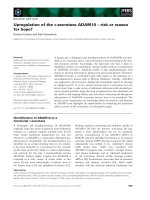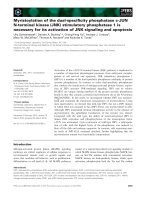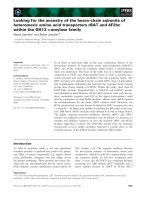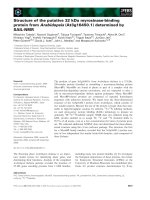Báo cáo khoa học: "Semantic Parsing: The Task, the State-of-the-Art and the Future" doc
Bạn đang xem bản rút gọn của tài liệu. Xem và tải ngay bản đầy đủ của tài liệu tại đây (47.74 KB, 1 trang )
Tutorial Abstracts of ACL 2010, page 6,
Uppsala, Sweden, 11 July 2010.
c
2010 Association for Computational Linguistics
Semantic Parsing: The Task, the State-of-the-Art and the Future
Rohit J. Kate
Department of Computer Science
The University of Texas at Austin
Austin, TX 78712, USA
Yuk Wah Wong
Google Inc.
Pittsburgh, PA 15213, USA
1 Introduction
Semantic parsing is the task of mapping natural
language sentences into complete formal mean-
ing representations which a computer can exe-
cute for some domain-specific application. This
is a challenging task and is critical for develop-
ing computing systems that can understand and
process natural language input, for example, a
computing system that answers natural language
queries about a database, or a robot that takes
commands in natural language. While the im-
portance of semantic parsing was realized a long
time ago, it is only in the past few years that the
state-of-the-art in semantic parsing has been sig-
nificantly advanced with more accurate and ro-
bust semantic parser learners that use a variety
of statistical learning methods. Semantic parsers
have also been extended to work beyond a single
sentence, for example, to use discourse contexts
and to learn domain-specific language from per-
ceptual contexts. Some of the future research di-
rections of semantic parsing with potentially large
impacts include mapping entire natural language
documents into machine processable form to en-
able automated reasoning about them and to con-
vert natural language web pages into machine pro-
cessable representations for the Semantic Web to
support automated high-end web applications.
This tutorial will introduce the semantic pars-
ing task and will bring the audience up-to-date
with the current research and state-of-the-art in se-
mantic parsing. It will also provide insights about
semantic parsing and how it relates to and dif-
fers from other natural language processing tasks.
It will point out research challenges and some
promising future directions for semantic parsing.
2 Content Overview
The proposed tutorial on semantic parsing will
start with an introduction to the task, giving ex-
amples of some application domains and meaning
representation languages. It will also point out its
distinctions from and relations to other NLP tasks.
Next, it will talk in depth about various semantic
parsers that have been built, starting with earlier
hand-built systems to the current state-of-the-art
statistical semantic parser learners. It will point
out the underlying commonalities and differences
between the learners. The next section of the tuto-
rial will talk about the recent advances in extend-
ing semantic parsing to work beyond parsing a sin-
gle sentence. Finally, the tutorial will point out
the current research challenges and some promis-
ing future directions for semantic parsing.
3 Outline
1. Introduction to the task of semantic parsing
(a) Definition of the task
(b) Examples of application domains and meaning
representation languages
(c) Distinctions from and relations to other NLP
tasks
2. Semantic parsers
(a) Earlier hand-built systems
(b) Learning for semantic parsing
i. Semantic parsing learning task
ii. Non-statistical semantic parser learners
iii. Statistical semantic parser learners
iv. Exploiting syntax for semantic parsing
v. Various forms of supervision: semi-
supervision, ambiguous supervision
(c) Underlying commonality and differences be-
tween different semantic parser learners
3. Semantic parsing beyond a sentence
(a) Using discourse contexts for semantic parsing
(b) Learning language from perceptual contexts
4. Research challenges and future directions
(a) Machine reading of documents: Connecting with
knowledge representation
(b) Applying semantic pars ing techniques to the Se-
mantic Web
(c) Future research directions
5. Conclusions
6









